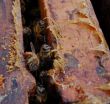International teams of researchers, led by the University of Leeds, studied the location and behaviour of magma chambers on the Earth's mid-ocean ridge system - a vast chain of volcanoes along which the Earth forms new crust.
They worked in Afar (Ethiopia) and Iceland - the only places where mid-ocean ridges appear above sea level. Volcanic ridges (or "spreading centres") occur when tectonic plates "rift" or pull apart. Magma (hot molten rock) injects itself into weaknesses in the brittle upper crust, erupting as lava and forming new crust upon cooling.
Magma chambers work like plumbing systems, channelling pressurised magma through networks of underground "pipes".
The studies, published in Nature Geoscience, reveal new information about where magma is stored and how it moves through the geological plumbing network. Finding out where magma chambers lie and how they behave can help identify early warning signs of impending eruptions.
Scientists used images taken by the European Space Agency satellite Envisat to measure how the ground moved before, during and after eruptions. Using this data, they built and tested computer models to find out how rifting occurs.
Data in one study showed magma chambers that fed an eruption in November 2008 in the Afar rift of Northern Ethiopia were only about 1 km below the ground. The standard model had predicted a depth of more than 3 km.
It is highly unusual for magma chambers to lie in shallow depths on slow spreading centres such as the Afar rift, where tectonic plates pull apart at about the same speed as human fingernails grow.
Dr Carolina Pagli from the University of Leeds' School of Earth and Environment, who led the study, says: "It was a complete surprise to see that a magma chamber could exist so close to the Earth's surface in an area where the tectonic plates move apart so slowly. The results have changed the way we think about volcanoes."
Dr Pagli also noticed that the ground started "uplifting" (elevating) four months before the eruption, due to new magma increasing pressure in one of the underground chambers. Understanding these precursory signals is fundamental to predicting eruptions.
A wider study of eruptions in Afar and Iceland, two vastly different environments, found remarkable similarities. Many events occurred within a short space of time. Researchers identified multiple magma chambers positioned horizontally and vertically, allowing magma to shoot in several directions. Moving magma triggered earthquakes, and separate magma chambers fed single eruptions.
The 2008 eruption is part of an unusual period of recent volcanic unrest in Ethiopia, and is enabling scientists to learn more about volcanoes at spreading centres. Most spreading centres are under 2 km of water at the bottom of the ocean, making detailed observations extremely challenging. The new knowledge derived from Ethiopian volcanoes will help scientists understand volcanoes in Iceland, where eruptions can have a bigger impact on the UK.
Dr Tim Wright from the School of Earth and Environment, who leads the international Afar Rift Consortium, said: "The dramatic events we have been witnessing in Afar in the past six years are transforming our understanding of how the crust grows when tectonic plates pull apart. Our work in one of the hottest place on Earth is having a direct impact on our understanding of eruptions from the frozen volcanoes of Iceland."
###
The studies were funded by the UK Natural Environment Research Council through the Afar Rift Consortium, the National Centre for Earth Observation, the US National Science Foundation, the UK Royal Society, and the Icelandic Research Fund.
Geophysical constraints on the dynamics of spreading centres from rifting episodes on land by Tim J Wright, Freysteinn Sigmundsson, Carolina Pagli, Manahloh Belachew, Ian Hamling, Bryndis Brandsdottir, Derek Keir, Rikke Pedersen, Atalay Ayele, Cindy Ebinger, Pall Einarsson, Elias Lewi and Eric Calais is published in Nature Geoscience, doi: 10.1038/NGEO1428
Shallow axial magma chamber at the slow-spreading Erta Ale Ridge by Carolina Pagli, Tim J Wright, Cynthia J Ebinger, Sang-Ho Yun, Johnson R Cann, Talfan Barnie and Atalay Ayele is published in Nature Geoscience, doi: 10.1038/NGEO1414
To request an interview with Dr Wright or Dr Pagli please contact: University of Leeds press office, T: 0113 343 34031 (30 March – 10 April) or press officer Esther Harward, T: 0113 343 4196 E: e.harward@leeds.ac.uk (from 11 April).
A current photograph of the Erta Ale lava lake at the Afar rift (studied in both papers) is available for media to download here: http://goo.gl/OIJB1. The photo must be credited to James Hammond.
A 3-D computer-generated flyover of the Afar rift may be used free of charge provided it is credited as follows: Copyright British Geological Survey, UK Natural Environment Research Council and US National Science Foundation. http://see.leeds.ac.uk/afar/new-afar/day-in-life/movie-files.html Please click on Afar_3D_motion_movie.
Notes to editors
The Afar Rift Consortium is a 5-year interdisciplinary project investigating rifting in Afar. It involves scientists at the Universities of Leeds, Bristol, Edinburgh, Oxford and Cambridge, with partners at the British Geological Survey and in the United States, France, New Zealand, and Ethiopia.
The National Centre for Earth Observation is a partnership of scientists and institutions, from a range of disciplines, which is using data from Earth observation satellites to monitor global and regional changes in the environment and to improve understanding of the Earth system to predict future environmental conditions.
The 2008 Research Assessment Exercise showed the University of Leeds to be the UK's eighth biggest research powerhouse. The University is one of the largest higher education institutions in the UK and a member of the Russell Group of research-intensive universities. The University's vision is to secure a place among the world's top 50 by 2015. www.leeds.ac.uk
END


